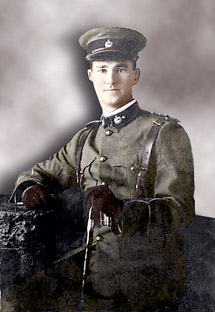
Major Hugh QUINN
Clicking on Photo will return to Page N,O,P,Q,R
Major Hugh (Mentioned in Despatches)
Officer Commanding C Company,
15th Battalion, Australian Imperial Force
Born 6th May 1888 at Rutherford Street, Charters Towers, Queensland
Educated: Central State School and Millchester State School, Charters Towers, and The Southport Church of England Grammar School for Boys ('Dixon's'), Queensland
Single; Public Accountant and Local Authorities Auditor, Sharebroker and Auctioneer, of Charters Towers and Townsville, Queensland.
Next of Kin listed as:Mother; Mary Jane Quinn (nee Irwin), of Gladstone Hotel, Charters Towers, Queensland [Father; the late John Quinn]
Photos of Major Quinn are known to exist in the following locations:
AWM H17420. Group photo Chataway p18 (facing). Group Photo Army Journal No. 270 (November 1971) p30. Brisbane Courier 2 Aug 1915